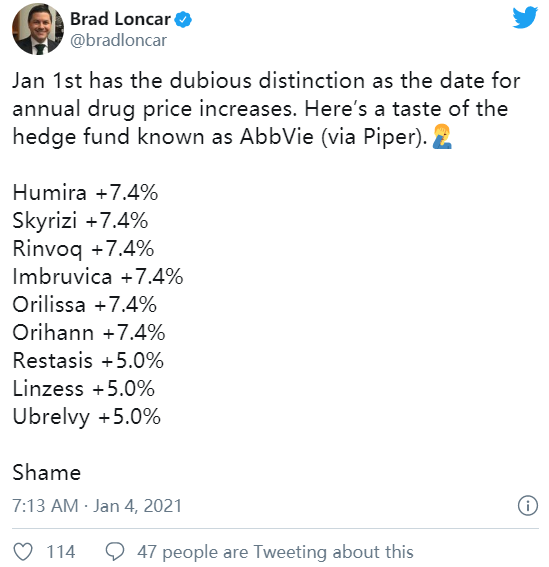开发新药并不容易,这是一个充满巨大压力、不可预测的过程,需要耗费大量精力。即便如此,还是可能会让全世界最伟大的科学家和他们所服务的患者在一瞬间希望破灭。首次临床试验的成功,也可能迅速以惨败收场。
然而,当艰难的药物开发过程和制药行业改变人生这一独特的使命,遇到美国政府对于监管药价基本放任自流的态度,事情就会陷入混乱之中。在目前的系统下,无论某种药品已经上市了多长时间,艾伯维(AbbVie)、辉瑞(Pfizer)、渤健(Biogen)等业内巨头几乎都可以在其定价方面一手遮天。每年,制药行业都在利用这种优势提高药价,2021年也不例外。
以艾伯维为例。艾伯维在2019年通过一笔大宗交易,收购了保妥适(Botox)生产商,也是它的同行公司艾尔建(Allergan)。艾伯维生产的修美乐(Humira)是全球最畅销的药品,仅2019年在美国的销售收入就接近150亿美元。这种消炎药物能够治疗牛皮癣、关节炎、克罗恩病等多种疾病。从这个角度来看,我们没有理由对科学横加指责。但修美乐早在2002年12月就已经获得批准。近20年后,艾伯维一直在提高这款药品的价格,尽管它的成分没有发生任何变化。
布拉德•隆卡是一位生物科技投资者,他和制药行业及其创新活动关系密切。但对这种为对冲科学失败风险而一再提高成本的模式,他也提出了批评。在艾伯维收购艾尔建时,隆卡曾经告诉《财富》杂志,这种模式鼓励金融工程而不是医学奇迹,而后者才是制药行业赖以生存的核心。你知道修美乐的价格在2021年伊始已经涨了多少? 7.4%。

对于这种情况,制药公司的高管也束手无策。制药行业人士经常辩解说,这种描述有失公平,因为药品的市场价格与医院或保险公司或者患者支付的价格并不匹配。
一名患者为药品支付的实际价格取决于其保险状况或大型制药公司提供的支付计划。除此之外,你还可能会发现现有药物的新用途。修美乐这类药物上市时可能只是针对一种疾病,但最终可能用于治疗十多种疾病。
这对普通美国人具有重要的财务影响。美国退休人员协会公共政策研究所(AARP Public Policy Institute)和明尼苏达大学(University of Minnesota)PRIME研究所(PRIME Institute)的数据显示,即使在最新一轮涨价之前,标准的40毫克修美乐注射笔的美国市场价(一年用量),从2006年的16,636美元涨到了2017年的58,612美元。
除了隆卡,生命科技领域的其他长期投资者也认为这种模式存在缺陷。今年,渤健用于治疗多发性硬化症的药物Tysabri也宣布了涨价。
本文单独提及的艾伯维和渤健已经宣布了涨价的消息,但其他许多公司也将遵循相同的模式。辉瑞、赛诺菲(Sanofi)和葛兰素史克(GlaxoSmithKline)都在酝酿涨价0.5%至8.6%,包括这些公司的多款拳头产品,例如辉瑞公司用于治疗癌症的Ibrance和消炎药Xeljanz等。(财富中文网)
译者:刘进龙
审校:汪皓
开发新药并不容易,这是一个充满巨大压力、不可预测的过程,需要耗费大量精力。即便如此,还是可能会让全世界最伟大的科学家和他们所服务的患者在一瞬间希望破灭。首次临床试验的成功,也可能迅速以惨败收场。
然而,当艰难的药物开发过程和制药行业改变人生这一独特的使命,遇到美国政府对于监管药价基本放任自流的态度,事情就会陷入混乱之中。在目前的系统下,无论某种药品已经上市了多长时间,艾伯维(AbbVie)、辉瑞(Pfizer)、渤健(Biogen)等业内巨头几乎都可以在其定价方面一手遮天。每年,制药行业都在利用这种优势提高药价,2021年也不例外。
以艾伯维为例。艾伯维在2019年通过一笔大宗交易,收购了保妥适(Botox)生产商,也是它的同行公司艾尔建(Allergan)。艾伯维生产的修美乐(Humira)是全球最畅销的药品,仅2019年在美国的销售收入就接近150亿美元。这种消炎药物能够治疗牛皮癣、关节炎、克罗恩病等多种疾病。从这个角度来看,我们没有理由对科学横加指责。但修美乐早在2002年12月就已经获得批准。近20年后,艾伯维一直在提高这款药品的价格,尽管它的成分没有发生任何变化。
布拉德•隆卡是一位生物科技投资者,他和制药行业及其创新活动关系密切。但对这种为对冲科学失败风险而一再提高成本的模式,他也提出了批评。在艾伯维收购艾尔建时,隆卡曾经告诉《财富》杂志,这种模式鼓励金融工程而不是医学奇迹,而后者才是制药行业赖以生存的核心。你知道修美乐的价格在2021年伊始已经涨了多少? 7.4%。
对于这种情况,制药公司的高管也束手无策。制药行业人士经常辩解说,这种描述有失公平,因为药品的市场价格与医院或保险公司或者患者支付的价格并不匹配。
一名患者为药品支付的实际价格取决于其保险状况或大型制药公司提供的支付计划。除此之外,你还可能会发现现有药物的新用途。修美乐这类药物上市时可能只是针对一种疾病,但最终可能用于治疗十多种疾病。
这对普通美国人具有重要的财务影响。美国退休人员协会公共政策研究所(AARP Public Policy Institute)和明尼苏达大学(University of Minnesota)PRIME研究所(PRIME Institute)的数据显示,即使在最新一轮涨价之前,标准的40毫克修美乐注射笔的美国市场价(一年用量),从2006年的16,636美元涨到了2017年的58,612美元。
除了隆卡,生命科技领域的其他长期投资者也认为这种模式存在缺陷。今年,渤健用于治疗多发性硬化症的药物Tysabri也宣布了涨价。
本文单独提及的艾伯维和渤健已经宣布了涨价的消息,但其他许多公司也将遵循相同的模式。辉瑞、赛诺菲(Sanofi)和葛兰素史克(GlaxoSmithKline)都在酝酿涨价0.5%至8.6%,包括这些公司的多款拳头产品,例如辉瑞公司用于治疗癌症的Ibrance和消炎药Xeljanz等。(财富中文网)
译者:刘进龙
审校:汪皓
Birthing a drug isn’t easy. It’s an intensive, unpredictable, and enormously stressful endeavor which can dash the hopes of the world’s greatest scientific minds and the patients they seek to serve. Initial clinical trial victories can quickly swerve into cataclysmic failures.
But that reality, and the unique nature of the pharmaceutical industry’s life-changing mission, gets messy when it mashes up against the largely laissez-faire attitude the U.S. government has toward regulating drug prices. The current system gives companies like AbbVie, Pfizer, Biogen, and all the titans of the industry nearly carte blanche on how to price their medicines, no matter how long ago they were created. The industry takes full advantage by hiking prices year after year, and 2021 is no different.
Consider AbbVie. The company, which acquired fellow drug firm and Botox maker Allergan in a 2019 megadeal, makes the world’s top-selling drug, Humira, which brought in nearly $15 billion in the U.S. alone in 2019. This anti-inflammatory medication treats a slew of diseases ranging from psoriasis to arthritis to Crohn’s disease. So there’s no reason to knock the science. But Humira’s first approval occurred way back in December 2002. Nearly two decades later, AbbVie is still hiking its price despite no actual change in what the drug actually is.
Brad Loncar is a biotech investor with an affinity for the industry and the innovation it breeds. He’s also a critic of a model that inherently incentivizes perpetual cost increases in order to hedge against the risk of scientific failure. It’s a model, as Loncar told Fortune during the time of the AbbVie-Allergan deal, which incentivizes financial engineering over the medical magic which is the beating heart of the industry. The latest Humira price hike for 2021? 7.4%.
This is the part of the story where pharmaceutical executives throw up their hands. The industry regularly argues this is an unfair characterization since list prices don’t match what a hospital pays, or what an insurer pays, or what a patient pays for a drug out of pocket.
The exact amount one is charged varies depending on your insurance status or payment programs set up by big drug companies. And, besides, you can learn new uses for an existing drug. A treatment like Humira which was launched to treat one condition may eventually treat a dozen.
That has serious financial implications for the average American. Even before this latest round of price hikes, the U.S. list price of the standard 40 mg Humira injectable pen ballooned from $16,636 for a one-year supply in 2006 to $58,612 in 2017, according to the AARP Public Policy Institute and the University of Minnesota’s PRIME Institute.
Alongside Loncar, other longtime investors in the life science community say the model is broken. Biogen is another offender this year with its treatment Tysabri, which is used for patients with multiple sclerosis.
While AbbVie and Biogen are being singled out for the price increases they have announced so far, plenty of other companies are following the same pattern. Pfizer, Sanofi, and GlaxoSmithKline are all plotting price hikes of anywhere between 0.5% and 8.6%, including for blockbuster medications such as Pfizer’s cancer drug Ibrance and its anti-inflammatory Xeljanz.






